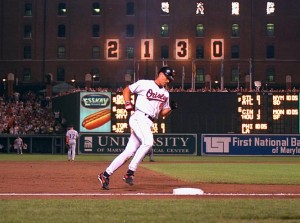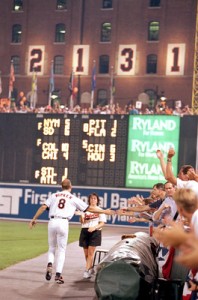15 Years Ago: Cal Ripken Jr. Restores Magic to Baseball

Before officially breaking Lou Gehrig's consecutive game streak on September 6, 1995, Cal Ripken Jr. blasted a home run in the contest against the Angels.
It is probably a bit of an overstatement to say that Cal Ripken Jr. saved major league baseball 15-years ago this week when he passed Lou Gehrig to become baseball’s all-time “Iron Man”. However, there is no question that Ripken played a huge role in the healing process following the most contentious labor strike in baseball history.
Baseball had been riding high in 1994 when a desire by the owners to institute a salary cap and the insistence by the players never to accept one halted the sport in its tracks. The World Series was not held for the first time in 90 years, leaving many fans bitter and vowing never to return to “America’s Pastime.”
The strike carried into the offseason and wasn’t resolved until a federal injunction against the owners leading to the resumption of baseball in late April 1995. Overall, the strike lasted 234 days and cancelled more than 900 games while in essence changing very little.
As could be expected, when baseball did return the fans were not rushing back to greet the players as long-lost heroes.
Instead, fans displayed their disillusion with both sides by staying away in droves as stadiums that were typically full were suddenly seeing large swaths of empty seats. Those who did come to the ballparks often brought with them signs reflecting their frustration with sayings such as “$hame on You” or shouted comments like “You ruined the game!”
For most of the 1995 season teams across the league saw attendance figures plummet as baseball struggled to regain the interest of fans who had realized there were other things to occupy time and interest.
In Baltimore, the Orioles struggled through a very disappointing season on the field. After being 14 games over .500 at the time of the strike in 1994, the 1995 Orioles struggled from the beginning and were above .500 for only one day (July 30th) the entire season.
However, even though the team wasn’t performing as hoped on the field, the Orioles were the one team whose attendance wasn’t seeing significant declines.
One example of the difference in how various places across the country accepted the return of baseball occurred in mid-May. Following a six-game homestand against Cleveland and Detroit during which 230,793 (38,466 per game) fans went through the turnstiles at Camden Yards, the Birds went on a 12-game road trip against the Yankees, A’s, Mariners and Angels where the total attendance was 198,927 (16,557 per game).
One reason for the quick recovery in Baltimore was the magic of Camden Yards, which opened in 1992 and was widely hailed as the first of the “retro parks.”
The other was a Baltimore player who with every game was taking one step closer to baseball immortality.

With every person he touched during his lap around the field, Ripken seemed to be bringing countless people across the nation back to the game of baseball.
Cal Ripken Jr., first put on a Baltimore Oriole uniform in 1981 and beginning during his rookie season in 1982, began an improbable streak of consecutive games played that by 1995 was nearing a record that many believed would never be broken.
Lou Gehrig had played 2,130 consecutive games during his career for the New York Yankees. In fact, it took a fatal disease to end the streak of the player known affectionately as the “Iron Horse.”
In the decades since his retirement in 1939, no player had come significantly close to challenging Gehrig… until Ripken.
During the 14 years it had taken Ripken to near the record, he had won two league MVP awards and revolutionized the position of shortstop in the major leagues.
Typically, when Ripken came into the league shortstops were slick fielding little guys with limited offensive prowess and generally no power production.
The 6-foot-4 inch Ripken seemed better suited to be a third baseman and that was indeed the position he played during his early days in the majors. However, during his rookie campaign manager Earl Weaver decided to move Ripken to shortstop and, as they say, the rest is history.
By 1995, Ripken was a 13-time All-Star and one of the most popular players in the league. Though much of his notoriety was simply for doing his job every day, at a time when sports fans were starting to see professional athletes as ungrateful millionaires who played for money instead of love of the game, Ripken seemed to be a throwback to a by-gone era when work ethic and love of the game were at the forefront.
As Ripken drew closer and closer to the record, the interest started to take hold across the country. The Orioles were regularly featured on national television and the crowds at both home and away games were increasing.
Ripken was set to tie the record in a game at Camden Yards on September 5th in a game against the California Angels. He would then pass the record the following night against the Angels in the final game of a homestand for the Orioles.
The entire 9-game homestand was a celebration of Ripken’s drive toward the record. Each night the number of consecutive games was emblazoned in large numbers across the B&O warehouse adjacent to the stadium and when the game became official the next number would be revealed in a brief ceremony.
The celebration reached a crescendo during the final two games against California when the electric atmosphere seemed more like that of a World Series than a mid-week series in early September.
On September 5th, the Orioles recognized the record tying game with a ceremony that included several of Ripken’s former teammates and other sports dignitaries. Ripken marked the occasion by recording three hits, including a home run in the sixth inning.
The following night, the entire baseball world was watching as Ripken hit a home run in the fourth inning. When the game became official halfway through the fifth inning, the magical number 2,131 was unveiled on the warehouse wall while the music from the movie “The Natural” blared over the sound system.
What followed was a 22-minute ovation that arguably started the healing process between major league baseball and its fans.
Though obviously a bit embarrassed by the ovation, Ripken acknowledged the cheers and then started to return to the dugout to prepare for the bottom of the fifth. However, his teammates pushed Ripken back out of the dugout and soon he began a slow trot around the edge of the field that included handshakes and high fives with hundreds of fans who were lucky enough to be part of the special moment.
With every hand he touched, Ripken seemed to bring not just that fan back to the game, but countless other fans that were watching across the country and connecting with the moment. By the end of his trek, you couldn’t help but sense that baseball had turned a corner and was going to be okay.
Ripken went on to play in 2,632 consecutive games before sitting out a September game at Yankee Stadium in 1998. His retirement in 2001 included a series of special ceremonies at stadiums across the league as fans across the baseball world thanked Cal for his 20 years of greatness.
Though it has now been 15 years, Ripken’s memorable games still bring a chill and are unquestionably among the greatest moments in baseball history.
Unlike the home run chase three years later between Sammy Sosa and Mark McGwire that evoked similar emotions at the time, but have been proven over time to have been built on deception, there is nothing that has tarnished Ripken’s accomplishments.
In fact, if anything, some of the actions that have happened in baseball may make Ripken’s accomplishment even more significant today than it was 15 years ago.
Ripken didn’t take the easy route to greatness. He did it one day, one hit and one game at a time. Though he wasn’t the greatest player in baseball history, Ripken made himself into a superstar and ultimately a Hall of Famer.

Dear Sir / Madam,
We are the manufacturer of Horse Riding Gloves from Pakistan. We are heartily inviting you to see our Gloves range, Kindly see the link below:
http://mreuroproducts.trustpass.alibaba.com/produ…
Hope to get a positive reply from you soon.
If you have any Question, feel free to ask us.
Regards,
Mr. EURO
[email protected]
Fax: +92-52-4592183
YOUR CARL RIPKEN ARTICLE IS A GOOD ONE. IT'S WELL WRITTEN AND BRINGS BACK A LOT OF FOND MEMORIES. CAN'T RECALL, DID YOU EVER GET TO SEE HIM PLAY IN PERSON? I KNOW THAT DURING THIS PAST DECADE HE HAD PURCHASED A MINOR LEAGUE BASEBALL TEAM AND BUILT SOME LITTLE LEAGUE BASEBALL PARKS. WHAT'S HE UP TO NOW?
Thanks for some other fantastic article. Where else may just anybody get that kind of info in such a perfect approach of writing? I have a presentation subsequent week, and I am on the search for such information.
Awesome page. Thanks for showing!
Hi there colleagues, how is all, and what you would
like to say on the topic of this post, in my view its really amazing designed for me.